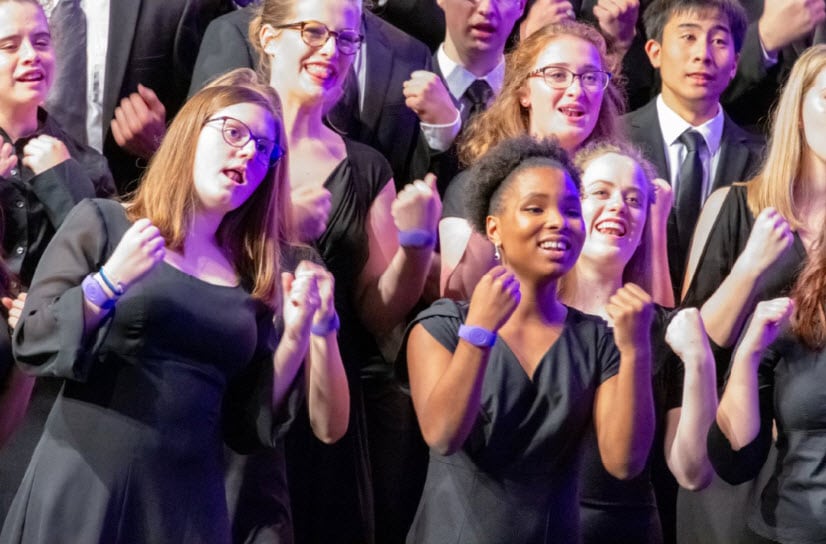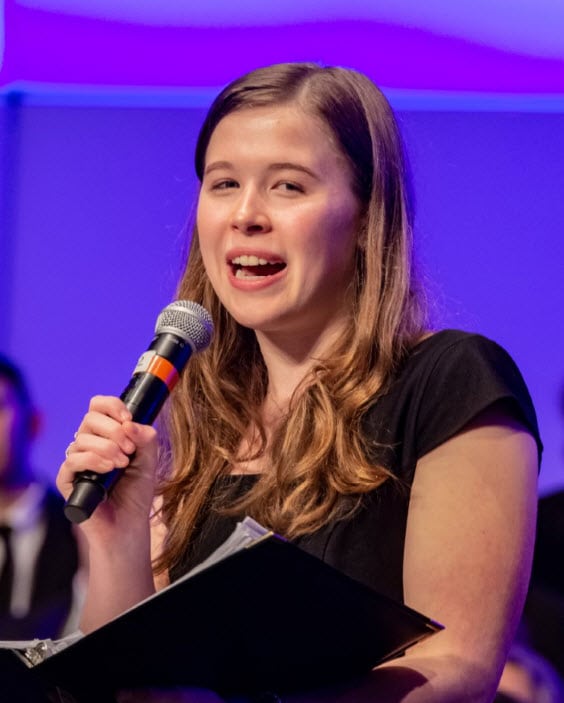/ News Posts / Group Improvisation in the Choral Rehearsal
Group Improvisation in the Choral Rehearsal
Three Improvisation Paradigms
By NAfME Member Christopher L. Clark, PhD
Chris Clark presented on “Group Improvisation in the Choral Rehearsal” during the NAfME 2021 PreK–12 Learning Collaborative in February 2021.
“Now, create a backdrop as Trey improvises on the text of Adinu. Listen and respond to him by creating moments of tension and resolution. Add notes to the drone when it feels appropriate. What does ‘I follow the religion of love’ mean to you?”
I first became interested in choral improvisation when I joined the Boston-based social justice choir Voices 21C (V21C). This semi-professional ensemble is made up of skilled musicians who share a social-justice worldview and embrace high-quality performances with actionable results. The ensemble uses improvisatory elements in performance, where we will have aleatoric improvised sections within notated works, create new works, and, since the pandemic, create socially distanced improvised works of art using Soundtrap (see The Choral Commons).
Many members of Voices 21C are also music teachers, and we have all found ways to incorporate facets of V21C in our teaching. With my high schoolers, I have been exploring ways to use improvisation as a means of expression and to solidify their growing musical skills. There is very little research on vocal improvisation outside of jazz ensembles. However, as improvisation exists at the intersection of composing and performing (the Creating Strand of the 2014 Music Standards), it can be a great vehicle for self-expression and solidifying musical skills, and even used in performance. I have been using three improvisation paradigms in my teaching.
Improvisation Paradigms
With the Soundscape paradigm, students vocally improvise a scene from their imagination. They explore evocative places such as the beach, a train station, and wind-swept fields. The positives of this paradigm are that there are few skills necessary to be successful, it builds camaraderie (as it can be a little silly), and it grows the possibilities for vocal improvisation. Negatives are mostly that there are few ways to transition these skills to notated music.
With the Progressive Melodic Skill Building paradigm, students improvise melodically using solfege and simple rhythms. For example, the teacher plays a looping chord progression of I-IV-vii-I while students improvise using the pitch of DO and rhythm of quarter notes and quarter rests. Eventually, students expand their pitch usage to DO and SOL, while the teacher plays a chord progression of I-IV-V-I. Students must hear or anticipate the chord change to know to when to switch solfege. Eventually, solfege is expanded to a pentatonic scale, with quarter notes, eighth notes, half notes, and all related rests as performance possibilities. This method can increase students’ musical skills and reinforces theory and sight-reading skills. However, it takes more time and attention to scaffold the improvisations.
The final paradigm is Drone/Repeating Pattern-Based. In this paradigm, students improvise repeating patterns, either harmonic, melodic, or ostinato, which fit together and are then expanded on. For example, the basses improvise a harmonically static bassline. That bassline is looped, and the other sections improvise lines that fit into that pattern. Once students are comfortable with the process, they can start imbuing the improvisations with different characters. This year, my students made a drone improvisation that led to the opening solo of Can You Hear by Jim Papoulis. We worked on finding places of tension (dynamics, dissonance, vowel sound) and relaxation (consonance, dynamics, and vowel sound). Students said that they enjoyed the process of creating a new idea to a notated piece.
There are several guidelines to help students be successful in vocal improvisations.
Rules for Group Improvisation
- Less is often more—Students often think they should sing the whole time, which can muddy the sound. Have students find certain times to improvise. Have them listen more than they sing.
- Designate leaders—Let the leaders control their sections using hand signals. However, change the leaders up often so everyone has a chance to lead.
- Know your role—A student’s role can change in an improvisation. Not everyone is the focus all the time. Have them listen to the sound that is being created and find their place in it.
- Know the intent—There are wrong answers in improvisation, such as a sound made without the correct intent. Every singer should understand the intent of the improvisation.
- This is play time—Students can and should make mistakes, as it is how they learn. Brand improvisation time as play time, where mistakes are encouraged, and students should be more open to mistakes.
So, play around, and see what your students can come up with. I have included a link to Voices 21C performing Ella’s Song by Bernice Johnson Reagon at the 2018 ACDA Eastern Division Conference, which is largely improvised. Happy improvising!
References
Ella’s Song by Bernice Johnson Reagon
About the author:
NAfME member Dr. Christopher L. Clark, PhD, is the Director of Choirs at Case Western Reserve University in Cleveland Heights, Ohio. He received his PhD from The University of Hartford’s Hartt School of Music, and a double Masters in Music Education and Choral Conducting from Bowling Green State University. Clark’s research interests include the intersection of choral music educators and their religiosity, group choral improvisation, and social justice. A 2013 Yale “Distinguished Music Educator,” Clark performs with Boston-based social justice choir, Voices 21C, and is a frequent guest clinician and presenter.
Did this blog spur new ideas for your music program? Share them on Amplify! Interested in reprinting this article? Please review the reprint guidelines.
The National Association for Music Education (NAfME) provides a number of forums for the sharing of information and opinion, including blogs and postings on our website, articles and columns in our magazines and journals, and postings to our Amplify member portal. Unless specifically noted, the views expressed in these media do not necessarily represent the policy or views of the Association, its officers, or its employees.
June 14, 2021. © National Association for Music Education (NAfME.org)
Published Date
June 14, 2021
Category
- Ensembles
- Innovation
- Jazz Education
- Repertoire
Copyright
June 14, 2021. © National Association for Music Education (NAfME.org)







